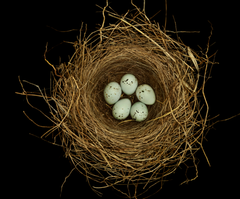The Glückspilz (Lucky Mushroom) Tradition
My Growing Traditions offers a selection of German Christmas ornaments depicting the Amanita muscaria Mushroom with its white-spotted bright red cap. Amanita muscaria (common name fly mushroom, or fly agaric), a toadstool, is toxic - dangerously poisonous - and should NEVER be tasted.
But, it should be enjoyed on your Christmas tree.
In the German and other European cultures, the mushroom is seen as a good-luck symbol - Glückpilz (Lucky Mushroom - colloquial "Lucky Duck, Dog, Devil, etc.") - and is "The Mushroom" of Christmas and the New Year, especially as a symbol of a blessing at the turn of the New Year. It honors a reverence of nature and the beauty of the forest - if you find one it is believed to bring you good fortune. It is acknowledged to be the most recognized mushroom on earth. This famous mushroom abounds in Christmas decorations, children's story books, and fairy tales.
As a good-luck symbol and a symbol respecting the beauty of nature the Amanita muscaria mushroom is a traditional ornament on German Christmas trees.
The Christian Ulbricht Workshop from the Erzgebirge, Germany - since 1928 - brings us this dear wooden ornament with an Amanita muscaria:
And, Inge-Glas of Germany brings us several Amanita muscaria glass Christmas ornaments
Add a little Glückpilz - Lucky Mushroom to your Christmas!
Legend of the Bird's Nest

Add the Legend of the Bird's Nest to your Christmas traditions.
You may also enjoy our Inge-Glas Pinterest Board.
The German Pickle Ornament - Traditions, Legends, and History
The German Pickle Ornament offers the opportunity for a family to establish a really fun tradition on Christmas morning. As the legend goes: To be hidden on the tree Christmas Eve - the child to first find the pickle ornament on Christmas morning receives a special gift. Inge-Glas of Germany makes three different sizes of the pickle. As the child grows the pickle hung on the tree becomes smaller. We offer a full set of the three sizes in a wood-chip gift box: And, we offer them individually: - the largest pickle is for the toddler
And, we offer them individually: - the largest pickle is for the toddler
- the medium-sized pickle for a pre-school child
- the smallest pickle for a child in elementary school, or in fact for the child in all of us.
All come with legend cards.
We offer you the possibility to innovate with this tradition. The following are alternative activities you might want to offer the child who finds the pickle. He or she:
- has good luck throughout the year
- opens the first present Christmas morning
- gives the first present Christmas morning - says Grace or reads a poem at Christmas dinner
- is the Secret Santa for the day (secretly doing something special for family members or friends)
or, create your own.
Christmas historians have had difficulty pinpointing the origins of this tradition. Inge-Glas notes in their book Christmas and Traditions by Klaus and Birgit Mueller-Blech, that "no one knows who, what or why, but it's a Christmas tradition to be enjoyed, even by the shy."
The German Christmas Pickle Tradition provides the best discussion of the issue that we could find. Rita Mace Walston, of About.com's "Germany for Visitors" heard from one individual who provided a story about a Bavarian born in 1842 who fought in the American Civil War. According to family lore, he was captured and sent to prison. He begged a guard for "just one pickle before he died." The guard acquiesced and the pickle - "by the grace of God - gave him the mental and physical strength to live on." Eventually returning to Germany, he, according to this tale, began the tradition of hiding a pickle on the Christmas tree. "The first person who found the pickle on Christmas morning would be blessed with a year of good fortune."
A second explanation connects the creation of the legend to the glass-blowing town of Lauscha in Germany. Among the first glass figural ornaments (glasschmuck) were ones in the shape of fruits and nuts. The pickle could easily have fit into this category. As they note, F.W. Woolworth began importing glass ornaments into the United States from Lauscha around 1880.
We found another source that added a tiny bit of information to the puzzle. The Glass Ornament: Old & New. A Collector's Compendium and Price Guide by Maggie Rogers with Judith Hawkins, 1983, researched when specific glass ornaments arrived on the U.S. ornament market. They report that Pickles from Lauscha-Steinheid, Germany were exported to the United States from Germany from the 1870s to 1939. No ornaments were available during World War II. The pickle was an ornament made in a mould - the glass being mouth-blown into the mould. Their scarcity index was: Rare. The pickle ornaments are said to have come in various shapes: "dills, gherkins, etc."
Wherever the pickle legend originated, they are a fun tradition that everyone in the family can look forward to.


















